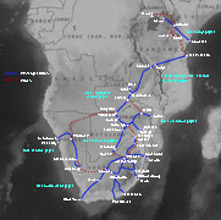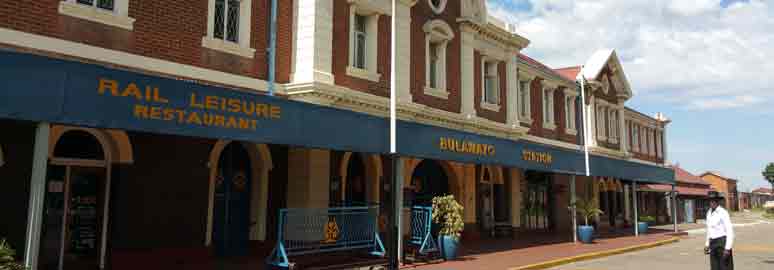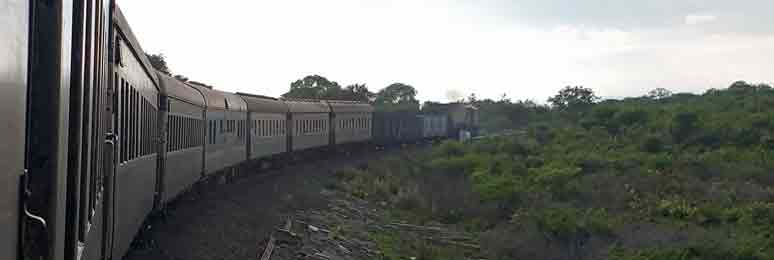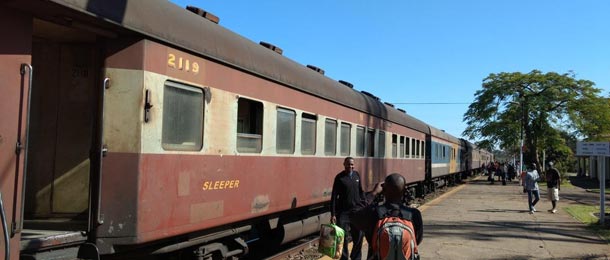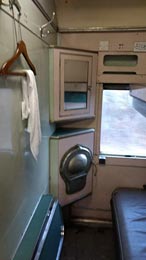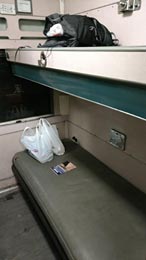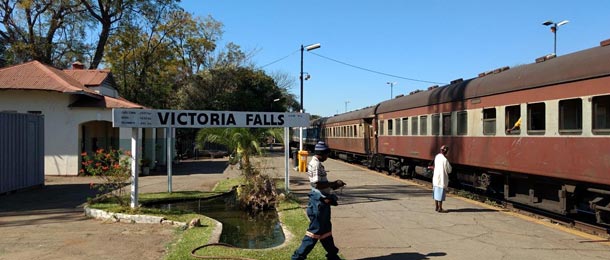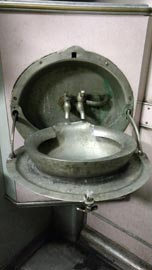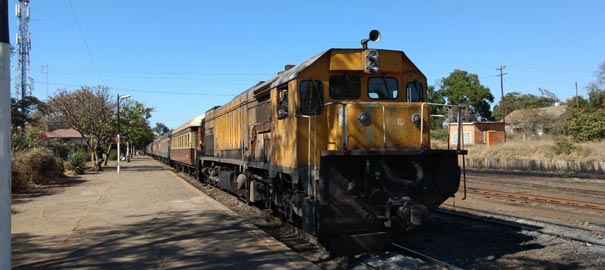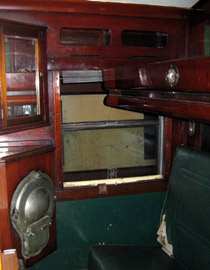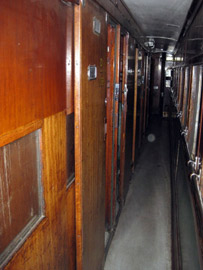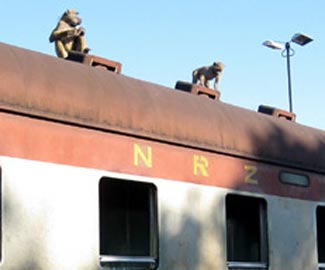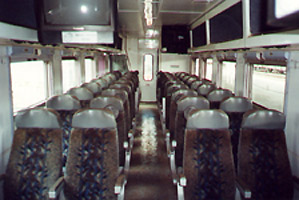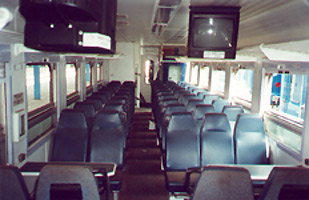Taking the train around Zim...
Trains link Victoria Falls, Bulawayo, Harare and various other cities. Not only a way to get around, they're an adventure and travel bargain too.
Useful country information
Bulawayo to Victoria Falls by train
This classic overnight train is the way to reach Vic Falls from Bulawayo, even though (given Zim's economic situation) it's now getting very down-at-heel. But don't be put off, ignore anyone telling you to spend a night in a cramped bus seat (or worse, fly), don't miss this amazing rail travel adventure, a classic piece of history with British-built coaches, some with wood-panelled interiors, dating from 1952 & 1958. You may even see some wildlife. Don't just take my word for it, see the travellers' reports below. If you have any updates about this train, please email me.
UPDATE 2025: Passenger trains in Zim have been suspended since the pandemic. However, from 17 October 2025 a weekly passenger train is restored between Bulawayo & Victoria Falls as shown below. A weekly Harare-Mutare train is also restored.
You can check times at www.nrz.co.zw. Bulawayo to Vic Falls is 472 km.
The train has economy & standard seats, and 2nd class sleeping berths. Feedback appreciated!
How to buy tickets
The following relates to the pre-pandemic situation for ticket sales, the arrangements for the train reinstated in October 2025 are not known.
-
You can buy tickets at Bulawayo station reservation office or the Victoria Falls reservation window, usually only on the day of travel. Reservations are not fully computerised, and can only be made for trains leaving from that station. The ability to book up to 30 days in advance has been discontinued. Just make reservations for your return journey when you reach your destination.
-
In Bulawayo, the reservations office is open 08:00-19:30 on Mondays-Fridays, 16:00-19:30 on Saturdays & Sundays.
-
Although the train appears to be well used, it's a long train with plenty of berths available, and there is unlikely to be a problem getting a place even for travel on the same day. You could try calling Bulawayo station - numbers are reportedly +263 9 362284, +263 9 362517 and +263 9 362840.
-
Tip: Ask about adding bedding to your booking when you buy tickets.
-
A cautionary tale: One seat61 correspondent had asked at his hotel and at a travel agency and been told both times that this amazing train wasn't running, and hadn't done so for at least 5 months. I was able to tell him that I had received an email from someone only 3 weeks ago whose first words to me were "I travelled on this train last night...". So please don't believe everyone you ask, go to the station yourself at the opening times specified on this page and ask Zimbabwe Railways themselves. It is running unless I hear otherwise!
What is the train like?
The following relates to the pre-pandemic train that ran for many years. The train reinstated in October 2025 appears to have economy and standard class seats, but no sleepers.
The Bulawayo-Victoria Falls train has 3 classes:
-
1st class sleepers, which have 2-berth rooms (known as coupés) and 4-berth rooms (known as compartments). These have leatherette bench seats convertible to bunks, and each room has a fold-out washbasin with (if it works in your car) cold water. Bedding used to be provided for $4 extra, but it may or may not be available on your departure, ask about this when you buy tickets. The windows open for clear view of the countryside, and at night, you can use a metal / mesh screen to allow cool air in whilst keeping you secure. The carriage lights may not work, so a torch is handy!
-
2nd class sleepers, which are identical to 1st class sleepers except there are 3 berths per coupé and 6 berths per compartment. Bedding used to be available for a $4 extra charge, ask about this when booking tickets.
-
Economy class seats: Basic seating, and does not convert to berths.
In 1st class, 2 passengers travelling together will normally be booked into a 2-berth coupé, whereas a solo traveller will be booked into a 4-berth compartment with passengers of the same sex. If you pay for two tickets (perfectly affordable, given the fare) you can have sole occupancy of a coupé. The sleeping-cars are all British-built, the ones with wood-panelled interiors in Gloucester in 1952, the ones with the less attractive formica interiors in Birmingham in 1958. Although they now carry National Railways of Zimbabwe insignia, they are still painted in the original 'Rhodesia Railways' colours, and windows and mirrors are etched with the 'RR' logo. The coaches were in OK condition when I travelled myself in 2001, but admittedly have been let go a bit lately and are now fairly decrepit, given Zim's economic circumstances. I'm not clear if the wood-panelled 1952 cars are still used, most recent reports have included photos of the 1958 cars.
See a short video taken on the journey.
Latest reports suggest that many (indeed, most) of the cars are now painted National Railways of Zimbabwe blue & grey as shown in the photo below, courtesy of Rémi Favre. The Bulawayo-Vic Falls train may also now be using the 'new' sleeper class, standard class & economy class cars originally built in the 1980s for the Bulawayo-Harare route (see the photos in the Bulawayo-Harare section below), with some older cars mixed in. Feedback & any photos would be appreciated!
Travellers' reports
Traveller Erik Pierson rode the train in late 2017: "We bought first class tickets around lunchtime and got a 2 bed compartment. Everything worked, linen was delivered and very clean, the train was maybe not so clean, but we could watch the staff disinfecting and cleaning in the morning, so it was acceptable standard. The linen man made the beds after departure and followed the train all night, and took back the linen at arrival in Victoria Falls, all this for 2 customers and 4 USD each! There was a generator car, as well as some water to flush the toilet and a lock inside the compartment. Some problems climbing into the upper bed, since there was no ladder, but it worked. Nice staff and a wonderful trip, we could see giraffes, antelopes and monkeys from the train. Felt safe, with nice staff. Arrived maybe an hour late to Victoria falls due to heavy load, but we would not mind more delays, since the trip was so fascinating."
Traveller James Stephenson rode the Bulawayo to Vic Falls train in 2017: "I have just travelled through Zimbabwe and Zambia with my wife and two young children aged 9 and 7. We took the overnight train from Bulawayo to Victoria Falls. It was brilliant. The children loved it. The alternative is a bus through the day. We have done a few of these. If you have a choice then you must take the train. The train cost was $10 for the adults and $5 for children. That's cheaper than the bus and infinitely better. We paid $4 more each for the sheets and pillow. The were as clean as a top hotel. A man even made our beds for us before the train left. We were very nice to all those helping us in the lead up! It seemed they hadn't a white family on the train for a very long time. I went in to the station early in the day to book. It was very quiet and the booking man was very nice. I did stress that the children needed to be comfortable. The train left on time at 7.30pm. The train stops a lot. Our train unfortunately hit an elephant in Hwange so was slowed down. We still arrived at Victoria falls station at 10am. The station was quiet and peaceful - like stepping back in time. The train is old and not perfectly clean but it really is fine. We had a cabin to ourselves as there are four beds. We kept the windows open during the night even though it was cold (July). We watched the beautiful countryside go by in the morning. This is the only time I have written on social media about travel and we have travelled a lot around the world with our children. I vowed I would write because we had such a good time. Use some of the money you save on accommodation to treat yourself to afternoon tea at the Victoria falls hotel!"
Traveller Angus Wheeler travelled from Bulawayo to Vic Falls in 2017: "When I arrived at Bulawayo station I had no problem buying two first class tickets in a coupe for $12 per ticket. There was a train for Harare on Platform 1 and the Victoria Falls train on Platform 4. Travellers should allow plenty of time to get to the train as the platforms are very long and the Victoria Falls train was at the far end of its platform. The train was comprised of a baggage car, a generator car, a single first class sleeper, an operational second class sleeper, what appeared to be a semi derelict second class sleeper, a “diner” carriage and a couple of economy seated carriages. The first class carriage was painted in NRZ colours but was the 1958 stock, still with Rhodesian Railways logos. It was fairly grubby and a bit worse for wear with no water in the sink but there was light throughout the journey (there was even a shaver socket in the cabin but I don’t know whether this was functional or not). The toilet was perfectly functional and, I think, was cleaned in the morning. The blind in my cabin did not work but the windows in the cabin and in the corridor easily opened for taking photographs/taking in the scenery. I note a recent correspondent managed to getting bedding – this was not available on my train so I wonder whether if it depends on the crew or which of the two trains you are on. I had the feeling that the crew on my train were a bit more “relaxed and casual” about things compared to another train, where I saw the crew smartly dressed in uniforms.
Lack of bedding didn’t matter to me as I had a sleeping bag. The train was reasonably busy as it was the start of the school holidays. There was a backpacking couple in the cabin next to me with the rest of the train comprising locals and families visiting home from South Africa. The train left pretty promptly at 19.35. Security in my cabin was fine, with a working lock and a door chain. When moving about the train you had to be very careful as quite a lot of the carriage doors were banging open and shut – including by the toilet. The bunk was perfectly comfortable and I had a reasonable night’s sleep, waking up briefly when we passed the southbound sleeper at around 2am. I awoke in the morning at Thomson junction at around 6.30am. I had hoped for a cup of tea in the diner but the guard told me it was shut. Instead I had a breakfast of items I had bought in the well-stocked Pick and Pay supermarket in the centre of Bulawayo. The scenery was breath taking travelling through the bush, particularly with the mist in the valley bottoms. We had occasional stops at passing loops and these functioned as stations with many people boarding at these stops. We drew into Victoria Falls at around 09.40, later than the time table on the ZRW website but only 35 minutes late compared to the arrivals time board at Victoria Falls, which suggested that 09.05 was the expected arrival time. For the next two days I was in Victoria Falls the train did arrive around 09.05 so it seems pretty punctual. A journey time of 14 hours is comparable to the current length of time that it takes to carry by road, which is currently subject to numerous police check points.
So would I do this trip again? The answer is a definite yes, the train was very grubby and basic but this is more than outweighed by the experience of travelling through the bush with its spectacular views. In addition, you may also strike lucky and get a better cared for train."
Traveller Katherine Maughan rode the train in 2017: "My husband and I rode the train in March 2017, without any real issue, and it was a wonderful experience. Certainly a chance to see a bit more the countryside and meet people. We were easily able to book tickets day-of at the Bulawayo train station. $12 per berth for the first class tickets. I'd recommend getting a 4-berth, for a bit of extra room. Our train was one of the old Beresford trains (1950s?) built in Birmingham, England. We boarded the train shortly before 7:30 and it departed about 9:00 p.m. We arrived in Vic Falls at 11:30 a.m. - so not bad at all. Boarding was a bit chaotic and the train was quite full for us at departure. We did have a squatter in our compartment who we had to help relocate, and attracted a bit of attention when we boarded, but it all settled down within an hour of departure. We learned that the prior day's train had been cancelled, which probably contributed to the crowds on our train - perhaps good for other travellers to know so they can have a back-up plan just in case. Since we had 12 hours in Bulawayo, we dropped our backpacks at the Bulawayo Club for the day. They also let us store a bit of food + water from the Pick N' Pay. They were really lovely, and have rooms available - so if you did find yourself stuck for a night that's a solid option. After the train departed, we had some periods where the electricity was working (impressive!) but needed our headlamps/torches for most of the ride. We brought our own sheets for the berths, as there's no longer any service providing bedding. Breakfast also doesn't appear to be served anymore. Door locked and we slept well. Once the sun came up we happily opened the door and had a chance to chat with passengers, enjoy the views, etc. While old, the train is surprisingly clean - bathroom was actually cleaned once in the morning! The sinks in the compartments no longer have running water and do smell quite strongly now (I suspect they may be experiencing a second-life as a convenient urinal for some travellers), so plan to open the window or toss a coin for the bottom bunk. The train makes many additional stops in the countryside, particularly between Hwange and Vic Falls. Anytime local people gathered at the tracks the train would stop, and operated more as a hop-on/hop-off throughout the countryside. (Not a huge surprise, but the Zimbabweans we spoke to indicated this is a distinct change from a few years ago.) We had a few curious people pop into our compartment in the morning after noticing the two westerners through the window, etc. I really recommend it to anyone who loves a good train ride. And, if you've got some time in Bulawayo a trip to the Railroad Museum (right near the station) is pretty fantastic, too!"
Traveller Douglas Tam used the Bulawayo to Vic Falls train in 2017: "I travelled alone in Zimbabwe last week and took the train from Bulawayo to Victoria Falls on 7th August. It was still impossible to purchase tickets before the day of travel. Tickets can be purchased up till half an hour before departure time on weekdays and up till the ticket office closes at 18:00 on Saturdays and Sundays. I bought two first-class tickets, each of which cost US$12, and was given my own coupé as per my request. The ticket seller also wrote down the carriage number and the compartment number on the back of one of my tickets. In the train, there were 3 economy-class carriages at the front, followed by 3 first-class carriages, and one baggage carriage at the end. The carriage numbers were clearly displayed on the carriages. All 3 first-class carriages were 1958 British-made Beresford carriages. The economy-class carriages had an odour which would linger throughout the journey to Victoria Falls. There was no restaurant car in the train, so passengers had to bring their own food. The supermarket closest to the railway station is the Pick n Pay on Fort Street, at the street corner of Fort Street and Khami Road. With as little as US$1, you can buy a delicious and filling sandwich there for dinner. All first-class passengers are allowed to sit in the waiting lounge inside the railway station, where you can relax on comfortable sofas while charging your mobile phone with the sockets inside and stay away from the hustle and bustle on the platforms. Clean toilets can be found inside the waiting lounge. I boarded the train at around 19:00 and the train departed at 19:30 sharp. It was half-full when it left Bulawayo that night. The whole train showed signs of wear: totally understandable given Zimbabwe's economic situation. There were two lights inside my compartment, but only one of them worked. The compartment door could be locked but could not be fully closed: there was a tiny, not-so-noticeable, gap through which I could see a small part of my compartment from the corridor, but passers-by would not be able to see the bed – the more 'private' part of the compartment. I gave the bed and the seat a good scrub with fifteen anti-bacterial wipes and all of them turned grey after use. The washbasin inside the compartment and the toilets at the two ends of the carriage were dirty and did not have running water. One of the carriage doors could not be shut and kept bouncing open throughout the journey. The original 1950s train carriage, with its original Rhodesia Railways décor intact, is a charming piece of artefact: its problems pale beside the allure of a by-gone era. There is a trick to folding the lower bunk away and turning it into a seat – a trick not even the conductor on my train knew at first. Sometimes, if you simply push the lower bunk up, it will fall down immediately. The trick to keeping the lower bunk upright is pulling it out towards yourself first before pushing it up. After I had discovered the trick, I went back to the conductor and told him about my discovery: he was amazed and asked me to show him how I did it. As at the time I took the train, bedding was still not available for purchase on the train, so I will advise everyone taking the train during winter to bring a sleeping bag or, like I did, put on extra layers. It was cold inside the train that night. By the following morning, the train was deep inside Hwange National Park where the scenery is beautiful. After Hwange National Park, the train would also go through Zambezi National Park, where the scenery is equally beautiful, before arriving at Victoria Falls. Wild animals roam these two national parks and you are bound to see more than one type of animals. This section of the railway also boasts a number of platformless rural railway stations: each of these stations is the end point of a footpath as wide as a 4-by-4 coming out of the forest and ending right at the railway track, where passengers stand patiently to wait for the train. There is no station building, not even a sign stating the station name. The spray of Victoria Falls came into view on the right-hand side when the train was 15 minutes away from Victoria Falls Station. National Railways of Zimbabwe's Web site states that the journey is a 12-hour one. However, it has since been stretched to a 14-hour journey. My train left Bulawayo at 19:30 and arrived at Victoria Falls at 09:30 the next morning. At Victoria Falls Station, the official scheduled arrival time of the train from Bulawayo was also given as 09:30. Victoria Falls Station is a small and quaint railway station built in the early 20th century. A taxi ride from the station to any hotel in the town costs less than US$10. Despite the poor condition of the carriages, travelling in an original 1950s train carriage while enjoying the beautiful natural scenery is a one-of-its-kind experience. I strongly recommend everyone travelling to Victoria Falls to take the train.
Things to do in Victoria Falls...
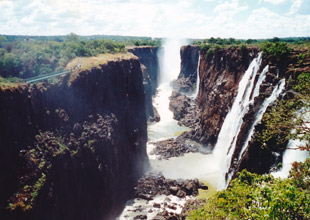 Victoria Falls... |
|
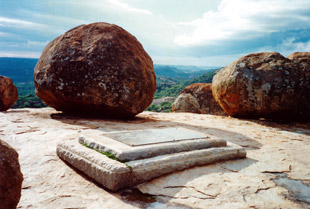 Cecil Rhodes grave, in a breath-taking spot in Matobo, on a rocky outcrop known as The view of the world. |
-
Visit the park to see the Falls from the Zimbabwe side. The park entrance fee is about US$ 30- take some waterproof clothing!
Walk across the frontier into Zambia to see the Zambian part of the Falls. Between the Zimbabwean and Zambian frontier posts you cross the famous steel bridge carrying the road and railway across the Zambezi between the Zimbabwean and Zambian sides of the river. Remember to have US$ 20 on you in US dollars cash (this may now have changed with the restoration of Zim$), as this is the cost of a Zambian one-day visa. Sterling is also accepted, but not South African Rand. If you pass any warthogs on the way, give them a wide berth...
Arrange a day trip to Chobe game reserve in Botswana. There are many operators offering similar trips. A 45-minute minibus transfer takes you from your hotel to the Botswana frontier. A 3-hour game drive in the Chobe National Park is followed by a 3-hour river trip with lunch. Animals include lion, impala, antelope, elephant, hippo, warthog, crocodile, mongoose, and even tortoise.
Take afternoon tea at the Victoria Falls Hotel, the poshest hotel in town. Staying there will cost you £150 per night. Afternoon tea (complete with cucumber sandwiches) will cost you more like £10. The hotel is right next to the railway station.
Go on an afternoon river cruise on the Zambezi. Many operators offer similar trips for the going rate of about £15, which includes plentiful wine or beer. You will probably see hippo and crocodile.
For those interested, there are a whole range of adventure activities available such as white water rafting down the Zambezi, or for the completely insane, bunji jumping off the Zambezi bridge.
...and in Bulawayo
Bulawayo is a pleasant town, well spread out with wide open streets and relatively little traffic. There is an excellent railway museum, which features Cecil Rhodes' private railway coach. You should not miss a day trip to the Matobo National Park, some 25 miles South of Bulawayo, where Cecil Rhodes is buried (see photo, right). Day tours generally visit the Whovi game reserve in the morning (famous for its rhinos), then the haunting hills of the main park in the afternoon.
Bulawayo to Harare by train
This train used to run daily, but was reduced to 3 times a week in 2009. Expect an arrival an hour or two late.
Update 2025: Passenger trains are still suspended in Zimbabwe post-pandemic, but check locally.
You can check times at www.nrz.co.zw.
Fares: Sleeper class $15, Standard class seat $12, Economy seat $10.
How to buy tickets
The only way to buy tickets is at Bulawayo and Harare station reservation offices, up to 30 days before departure. Reservations are not fully computerised, and can only be made for trains leaving from that station - reservations for your return journey will need to be made when you reach your destination. In Bulawayo, the reservations office is open 08:00-19:30 on Mondays-Fridays, 16:00-19:30 on Saturdays & Sundays. Opening times at Harare station are not known. It's best to get to the booking office early in the day, as there is one sleeping-car on this train which can get fully-booked (but see the section below about it being a 'staff only' sleeper!). Fares are not expensive - in the region of £20/$35 or less one way in a sleeper.
What's the train like?
New coaches were introduced on the Bulawayo-Harare overnight train in the 1980s, but these 'new' sleeper class cars seem to have ended up on the Vic Falls route and an older 1958-built 1st class sleeping-car has been deployed on the Bulawayo-Harare train. Indeed, this route now seems to be run as a mixed train, with goods wagons as well as passenger cars. In principle, there are 3 classes of accommodation on this train:
-
1st class sleeper: A classic 1958 car with 2-berth rooms (known as coupés) and 4-berth rooms (known as compartments). These have leatherette bench seats convertible to bunks, and each room has a washbasin which may or may not have any running water, see the sleeper photos in the Victoria Falls section above. The car is certainly not air-conditioned and no bedding is provided, but the windows open for a superb view of the countryside, and at night, a metal / mesh screen can be used to allow cool air in but keep you safe and secure.
Important: In 2019, so far two correspondents have reported being told that the sleeping-car was 'for staff only' which certainly shouldn't be the case. Both correspondents nevertheless managed to acquire sleeper berths on the train!
-
Standard class: comfortable airline-style seating.
-
Economy class: basic seating.
Traveller's reports
Traveller Edo Dijkstra reports from a Bulawayo to Harare trip in 2019: "I arrived yesterday in Harare by night train from Bulawayo at 13.15 hours ! It consisted of a lot of freight trucks (mixed trains seem to be the norm in Zimbabwe) 3 economy class cars, 2 standard class cars and a 1st class sleeping car from 1958. What I understand is that the sleeping car is no longer for general use but for railway staff use only! Luckily with the help of the curator of the railway museum I was able to get a berth in this coach anyway."
Traveller Ivor Ines reports from a Bulawayo-Harare trip in 2017: "The carriages for this train were introduced in 1998, but they are now much the worse for wear. Bedding was provided, though the attendant apologised profusely that there were no sheets, only blankets and pillows. Bedding was issued after departure, although as I didn’t realise this, I ran around before departure to check we wouldn’t be left blanket-less throughout a cold night. It seemed that quite a few passengers had brought their own bedding, even first class. The compartment window and screen still worked, in other words, opened, closed and locked in position. Although the main compartment lock was broken, there was still a security chain which I then padlocked closed, and we felt quite safe and secure during the journey. In standard class, although the TVs were still there, there was no sign of them working which is probably a positive, in terms of actually being able to sleep... The train had a great, wood panelled buffet car complete with bar area, restaurant area and full kitchen. Unfortunately, it was only serving drinks (sodas and beer, no hot drinks) and a few snacks like biscuits and strange-looking crisps, no substantive food. The train left Harare punctually at 9pm, but NRZ seem to have given up on any attempt at predicting arrival times. We arrived in Bulawayo around 10am, which I suspect is ‘normal’, although the staff said that sometimes freight wagons are attached to the passenger train, and so it runs even slower."
Other trains in Zimbabwe
Update 2025: All services remain suspended post-pandemic.
Harare to Mutare
The train has 1st & 2nd class sleepers and Economy seats. Distance 273km.
Fares: 1st class sleeper $7, 2nd class sleeper $5, Economy seat $4.
Bulawayo to Chiredzi
The train has 1st & 2nd class sleepers & Economy seats. Distance 523km.
Fares: 1st class sleeper $14, 2nd class sleeper $10, Economy seat $8.
Bulawayo to Beitbridge (South African border)
IMPORTANT: Bulawayo-Beitbridge service cancelled July 2014 until further notice. Still not running in 2019.
The train has 1st, 2nd & Economy class. Distance not known.
You can take local transport across the Beitbridge-Messina border and take the Shosholoza Meyl train from Messina to Pretoria & Johannesburg, see the South Africa page for times and days of running.
Bulawayo to Chicualacuala & Maputo (Mozambique): See the Mozambique page...
Other trains...
There are also twice weekly 'mixed' trains (meaning freight wagons and passenger car) from Harare to Shamva and from Harare to Lion's Den.
Fares & how to buy tickets
Expect the first class sleeper fare for all these overnight trains to be around US$10. Reservations cannot be made in advance, only on the day of travel, but outside peak holiday times it's no problem to get a place on the day.
International links...
South Africa - Zimbabwe by train or bus
Whatever you may read in your guidebook, there are now no direct scheduled trains from South Africa to Zimbabwe, and have not been for years. If your guidebook is some years old, it may mention weekly trains from Johannesburg to Harare and Bulawayo, but for political reasons (in fact, exorbitant haulage charges imposed by the National Railways of Zimbabwe) these were suspended in 1999. Similarly, the daily train that used to link Mafeking and Bulawayo via Gaborone was first (1999) cut back to run purely within Botswana, and was then (2009) completely withdrawn. In 2007, National Railways of Zimbabwe allegedly considered re-instating a Harare-Johannesburg train some time before 2010, but there's no sign of this happening. So there are now several less-than-brilliant choices for overland travel from SA to Zimbabwe:
-
Johannesburg - Messina/Beitbridge - Bulawayo by train+bus or train & train: There used to be an overnight Shosholoza Meyl economy train from Johannesburg or Pretoria to Messina, see train travel in South Africa - but it was discontinued in 2014. Messina is 12km short of the frontier at Beitbridge, from where you can take irregular African buses to both Harare and Bulawayo. There was a twice weekly train from Beitbridge to Bulawayo, see the section above, but this too has been discontinued.
-
Johannesburg - Bulawayo by bus: Two companies run modern buses overnight direct from Johannesburg/Pretoria to Bulawayo, with departures most nights. The journey is takes about 13 hours from Pretoria. Visit www.greyhound.co.za and res.prasa.com/translux/booking for details. Although neither as civilised or comfortable as a train, this is probably the simplest overland option.
-
Cruise trains from South Africa to Zimbabwe: If you have the money, there are several tourist 'cruise' trains. The Blue Train (www.bluetrain.co.za) operates from Pretoria to Victoria Falls about once a month. However, you can reckon on a one-way fare exceeding £500. Rovos Rail (www.rovos.co.za) also operate on this route. Check that these are still operating - Zimbabwe Railways' high haulage rates have hit these trains, too.
Botswana - Zimbabwe by train
The daily Mafeking-Gaborone-Francistown-Bulawayo train was cut back to running purely within Botswana in 1999. A Francistown-Bulawayo train service started in June 2006, running 3 times weekly with modern coaches (complete with TV entertainment!), see the Train travel in Botswana page for current status, train times and days of running.
Zambia - Zimbabwe by train
There are now no scheduled passenger trains across the famous Zambesi bridge from Victoria Falls (Zimbabwe) to Livingstone (Zambia). But you can walk across the bridge from Vic Falls to the Zambian border post and take a taxi the few miles on to Livingstone. Trains run from Livingstone to Lusaka and Kapiri Mposhi, where you can change trains onto the Tazara line to Dar es Salaam. See the Train travel in Tanzania & Zambia page for train times, fares & days of running.
Namibia - Zimbabwe by bus
A bus links Victoria Falls with Windhoek 3 times a week, see the Namibia page or www.intercape.co.za.
Mozambique - Zimbabwe by train: See the Mozambique page...
Hotels in Zimbabwe
 Backpacker
hostels
Backpacker
hostels
www.hostelworld.com: If you're on a tight budget, don't forget about backpacker hostels. Hostelworld offers online booking of cheap private rooms or dorm beds in backpacker hostels in most cities at rock-bottom prices.
Guidebooks
To get the most from a trip to Southern Africa, you'll need a good guidebook - and I think the Lonely Planet guides are about the best ones out there for independent travel.
 Click the images to buy
at Amazon.co.uk...
Click the images to buy
at Amazon.co.uk...
The Southern Africa guidebook is less detailed than the Zimbabwe one, but it covers South Africa, Botswana, Namibia, and several other countries in Southern Africa as well as Zimbabwe.
Travel insurance & other tips
Always take out travel insurance
Never travel overseas without travel insurance from a reliable insurer, with at least £1m or preferably £5m medical cover. It should also cover cancellation and loss of cash and belongings, up to a sensible limit. An annual multi-trip policy is usually cheaper than several single-trip policies even for just 2 or 3 trips a year, I have an annual policy with Staysure.co.uk myself. Here are some suggested insurers. Seat61 gets a small commission if you buy through these links.
![]() www.staysure.co.uk
offers enhanced Covid-19 protection & gets 4.7 out of 5 on
Trustpilot.
www.staysure.co.uk
offers enhanced Covid-19 protection & gets 4.7 out of 5 on
Trustpilot.
![]() www.columbusdirect.com
is also a well-know brand.
www.columbusdirect.com
is also a well-know brand.
![]() If you live in the USA try
Travel Guard USA.
If you live in the USA try
Travel Guard USA.
Get an eSIM with mobile data package
Don't rely on WiFi, download an eSIM with a mobile data package for the country you're visiting and stay connected. Most newer mobile phones can download a virtual SIM card so you don't need to buy a physical SIM, including iPhone 11 & later, see device compatibility list. Maya.net is a reliable eSIM data retailer with a 4.5 out of 5 Trustpilot rating and a range of packages including unlimited data.
Get a Curve card for foreign travel
Most banks give you a poor exchange rate, then add a foreign transaction fee on top. A Curve MasterCard means no foreign transaction fees and gives you the mid-market exchange rate, at least up to a certain limit, £500 per month at time of writing. The money you spend on your Curve card goes straight onto one of your existing debit or credit cards.
How it works: 1. Download the Curve app for iPhone or Android. 2. Enter your details & they'll send you a Curve MasterCard - they send to the UK and most European addresses. 3. Link your existing credit & debit cards to the app, you can link up to two cards with the free version of Curve, I link my normal debit card and my normal credit card. 4. Now use the Curve MasterCard to buy things online or in person or take cash from ATMs, exactly like a normal MasterCard. Curve does the currency conversion and puts the balance in your own currency onto whichever debit or credit card is currently selected in the Curve app. You can even change your mind about which card it goes onto, within 14 days of the transaction.
I have a Curve Blue card myself, it means I can buy a coffee on a foreign station on a card without being stung by fees and lousy exchange rates, just by tapping the Curve card on their card reader. The money goes through Curve to my normal debit card and is taken directly from my account (in fact I have the Curve card set up as payment card on Apple Pay on my iPhone, so can double-click my phone, let it do Face ID then tap the reader with the phone - even easier than digging a card out). I get a little commission if you sign up to Curve, but I recommend it here because I think it's great. See details, download the app and get a Curve card, they'll give you £5 cashback through that link.
Get a VPN for safe browsing. Why you need a VPN
When you're travelling you often use free WiFi in public places which may not be secure. A VPN encrypts your connection so it's always secure, even on unsecured WiFi. It also means you can select the geographic location of the IP address you browse with, to get around geoblocking which a surprising number of websites apply. See VPNs & why you need one explained. ExpressVPN is a best buy with a 4.7 out of 5 Trustpilot ranking which I use myself - I've signed up as an ExpressVPN affiliate, and if you go with expressvpn.com using the links on this page, you should see a special deal, 3 months free with an annual subscription. I get a small commission to help support this site.
Carry an Anker powerbank
Tickets, reservations, vaccination records and Interrail or Eurail passes are often held digitally on your mobile phone, so it's vital to keep it charged. I always carry an Anker powerbank which can recharge my phone several times over if I can't get to a power outlet. Buy from Amazon.co.uk or from buy from Amazon.com.


